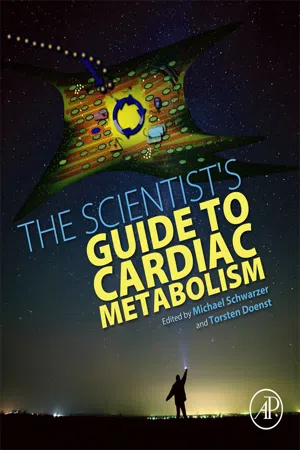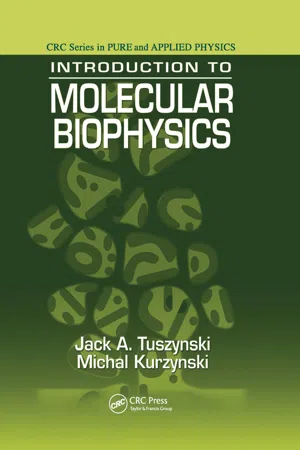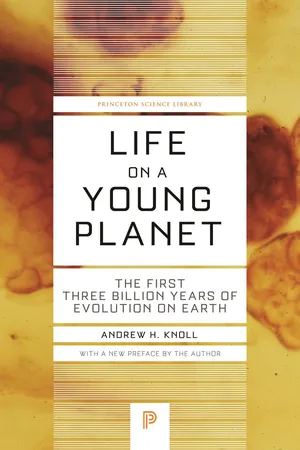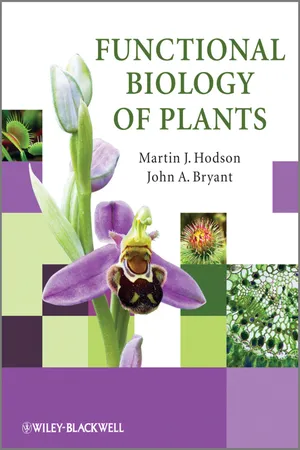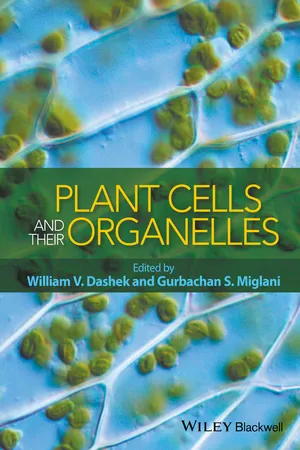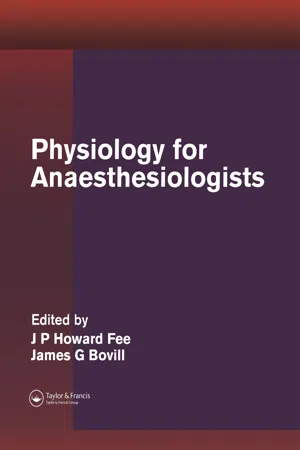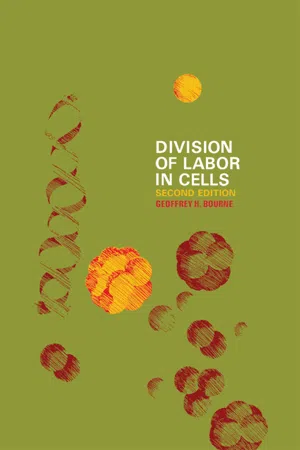Biological Sciences
Mitochondria and Chloroplasts
Mitochondria and chloroplasts are organelles found in eukaryotic cells. Mitochondria are responsible for producing energy in the form of ATP through cellular respiration, while chloroplasts are involved in photosynthesis, converting light energy into chemical energy in the form of glucose. Both organelles have their own DNA and are believed to have originated from endosymbiotic relationships with ancient prokaryotic cells.
Written by Perlego with AI-assistance
Related key terms
Related key terms
1 of 4
Related key terms
1 of 3
12 Key excerpts on "Mitochondria and Chloroplasts"
- eBook - ePub
- Britannica Educational Publishing, Kara Rogers(Authors)
- 2010(Publication Date)
- Britannica Educational Publishing(Publisher)
Mitochondria and Chloroplasts are the powerhouses of the cell. Mitochondria appear in both plant and animal cells as elongated cylindrical bodies, roughly one micrometre in length and closely packed in regions actively using metabolic energy. Mitochondria oxidize the products of cytoplasmic metabolism to generate ATP, the energy currency of the cell. Chloroplasts are the photosynthetic organelles in plants and some algae. They trap light energy and convert it partly into ATP but mainly into certain chemically reduced molecules that, together with ATP, are used in the first steps of carbohydrate production. Mitochondria and Chloroplasts share a certain structural resemblance, and both have a somewhat independent existence within the cell, synthesizing some proteins from instructions supplied by their own DNA.Mitochondrial and Chloroplastic Structure
Both organelles are bounded by an external membrane that serves as a barrier by blocking the passage of cytoplasmic proteins into the organelle. An inner membrane provides an additional barrier that is impermeable even to small ions such as protons. The membranes of both organelles have a lipid bilayer construction. Located between the inner and outer membranes is the intermembrane space.In mitochondria the inner membrane is elaborately folded into structures called cristae that dramatically increase the surface area of the membrane. In contrast, the inner membrane of chloroplasts is relatively smooth. However, within this membrane is yet another series of folded membranes that form a set of flattened, disklike sacs called thylakoids. The space enclosed by the inner membrane is called the matrix in mitochondria and the stroma in chloroplasts. Both spaces are filled with a fluid containing a rich mixture of metabolic products, enzymes, and ions. Enclosed by the thylakoid membrane of the chloroplast is the thylakoid space. The extraordinary chemical capabilities of the two organelles lie in the cristae and the thylakoids. Both membranes are studded with enzymatic proteins either traversing the bilayer or dissolved within the bilayer. These proteins contribute to the production of energy by transporting material across the membranes and by serving as electron carriers in important oxidation-reduction reactions.The internal membrane of a mitochondrion is elaborately folded into structures known as cristae. Cristae increase the surface area of the inner membrane, which houses the components of the electron-transport chain. Proteins known as F - No longer available |Learn more
- Mary Wuerth(Author)
- 2023(Publication Date)
- Barrons Educational Services(Publisher)
Chapter 14 of this book will explain why mtDNA is inherited in a non-Mendelian fashion. Mitochondria also contain their own ribosomes.Figure 5.7 MitochondrionChloroplasts are found in plants and algae that carry out photosynthesis. Like the mitochondria, chloroplasts also have a double-membrane structure. Chloroplasts have a smooth outer membrane and pancake-shaped membranous sacs called thylakoids that are stacked into structures called grana (singular: granum). The liquid inside the chloroplast that surrounds the grana is called stroma. (See Figure 5.8 .) The membranes of the thylakoids function in the light-dependent reactions of photosynthesis, and the enzymes in the stroma function in the light-independent reactions of photosynthesis. These processes will be discussed in detail in Chapter 8 . Like mitochondria, chloroplasts also contain their own chloroplast DNA (cpDNA) and their own ribosomes.Figure 5.8 ChloroplastThe centrosome, as shown in Figure 5.9 , is found in animal cells and helps the microtubules assemble into the spindle fibers needed in cell division. Defects in centrosome function have been associated with dysregulation of the cell cycle in some cancers.Figure 5.9 CentrosomePlant cells may contain amyloplasts, as shown in Figure 5.10 . Excess glucose produced by photosynthesis is stored as starch molecules in the amyloplasts. Amyloplasts are frequently found in the root and tubers of starchy vegetables, such as potatoes.Figure 5.10 AmyloplastThere are several other structures found in both plant and animal cells. The peroxisome helps oxidize molecules and break down toxins in the cell. The nucleolus is not a membrane-bound organelle; that term refers to the region in the nucleus where ribosomes are assembled. Cytoskeleton fibers help give cells their shape and can be used to move items in the cell. Figure 5.11 - eBook - ePub
- Laurie Ann Callihan, David Callihan(Authors)
- 2013(Publication Date)
- Research & Education Association(Publisher)
Mitochondria (plural of mitochondrion) are more numerous in cells requiring more energy (muscle, etc.). Mitochondria are self-replicating, containing their own DNA, RNA, and ribosomes. Mitochondria have a double membrane; the internal membrane is folded. Cellular respiration reactions occur along the folds of the internal membrane (called cristae). Mitochondria are thought to be an evolved form of primitive bacteria (prokaryotic cells) that lived in a symbiotic relationship with eukaryotic cells more than 2 billion years ago. This concept, known as the endosymbiont hypothesis, is a plausible explanation of how mitochondria, which have many of the necessary components for life on their own, became an integral part of eukaryotic cells. 10. The nucleus is an organelle surrounded by two lipid bilayer membranes. The nucleus contains chromosomes, nuclear pores, nucleoplasm, and nucleoli. The nucleolus (10a) is a rounded area within the nucleus of the cell where ribosomal RNA is synthesized. This rRNA is incorporated into ribosomes after exiting the nucleus. Several nucleoli (plural of nucleolus) can exist within a nucleus. The nuclear membrane (10b) is the boundary between the nucleus and the cytoplasm. The nuclear membrane is actually a double membrane, which allows for the entrance and exit of certain molecules through the nuclear pores. Nuclear pores (10c) are points at which the double nuclear membrane fuses together, forming a passageway between the inside of the nucleus and the cytoplasm outside the nucleus. Nuclear pores allow the cell to selectively move molecules in and out of the nucleus. There are many pores scattered about the surface of the nuclear membrane. Plant Cells The structure of plant cells differs noticeably from animal cells with the addition of three organelles: the cell wall, the chloroplasts, and the central vacuole. In Figure 3-6, the organelles numbered 1 to 7 function the same way in plant cells as in animal cells (see below). Fig - eBook - ePub
- Patricia Barnes-Svarney, Thomas E. Svarney(Authors)
- 2014(Publication Date)
- Visible Ink Press(Publisher)
Because the organelles found within eukaryotic cells share a number of similarities with bacteria—such as mitochodria and chloroplasts—many scientists believe that early versions of eukaryotic cells had symbiotic relationships with certain bacteria. In particular, the eukaryote provided protection and resources, while the prokaryote specialized in converting energy (either sunlight or chemical) into forms that could be used by the eukaryotic cell (sugar or ATP, or adenosine triphosphate)— thus the term endosymbiote, meaning “shared internal life.” In addition, structural similarities exist between chloroplasts, mitochondria, and free-living bacteria. (For more about ATP and energy, see the chapter “Basics of Biology.”) What are the cytoplasm and cytosol? The many organelles of the cell are suspended in a watery medium called the cytoplasm—the location of many of the cell’s chemical reactions. The cytoplasm includes everything within the plasma membrane except the nucleus. The cell membrane surrounds the cytoplasm at the cell’s surface; everything within the nuclear membrane (or envelope) is called the nucleoplasm. (For more about the nucleus, see below.) Cytosol is the liquid medium of the cytoplasm. If you take out all the organelles and the other components (the insoluble nonmembrane structures), you would have the fluid inside the cell, or cytosol. What are the largest and smallest organelles in a cell? The largest organelle in a cell is the nucleus; the next largest would be the chloroplast— only found in plant cells—which is substantially larger than a mitochondrion. The smallest organelle in a cell is the ribosome (the site for the manufacture of proteins within the cell). What organelles of eukaryotic cells contain DNA? Eukaryotic cells have several DNA-containing organelles. DNA is found in nuclei (where it is called chromosomal DNA) and mitochondria (called mitochondrial DNA) - eBook - ePub
- Michael Schwarzer, Torsten Doenst(Authors)
- 2015(Publication Date)
- Academic Press(Publisher)
Chapter 3Metabolically Relevant Cell Biology – Role of Intracellular Organelles for Cardiac Metabolism
Bernd Niemann*Susanne Rohrbach†* Department for Adult and Pediatric Cardiac Surgery and Vascular Surgery, University Hospital Giessen and Marburg, Justus Liebig University Giessen, Rudolf Buchheim Strasse, Giessen† Institute for Physiology, Justus Liebig University Giessen, Aulweg, GiessenAbstract
Living organisms consist of cells ranging from unicellular to multicellular organisms. Complex live-forms with further cellular specialization was evolutionarily needed to generate higher organs and organisms. While prokaryotic organisms exhibit simple phenotypes, eukaryotic cells develop specialized structures and cellular compartments to meet demands of function and energy supply during evolution. Endosymbiotic life of eukaryotic cells with prokaryotes, which means enduring integration of Mitochondria and Chloroplasts into eukaryotic cells – might be understood as fundamental and vital for further evolutionary development. Balance between energy supply and metabolic detoxification is needed to allow adequate cellular function, survival, and replication while dysregulation and oxidative impairment of organelles may lead to metabolic collapse, dysfunction, and finally cell death.Keywords
mitochondria peroxisome endoplasmic reticulum ribosomes Golgi apparatus vesicles cell deathCellular compartments
Eukaryotic cells exhibit different compartments, each of those processing functional specialization. Coated by the plasmatic membrane cytosol, cytoplasm and cellular organelles are separated to compartmentalize the environment of specified biochemical reaction. Thus, construction, maturation, modification, and degradation of proteins are spatially separated by biomembranes. Within eukaryotes, organelles exhibit a characteristic pattern meeting the cellular needs of specialization. Thus, skeletal myocytes and in particular cardiac myocytes exhibit enormous amounts of mitochondria (mt), which can represent up to a third of the cellular volume. Organelles, virtually identifiable in all cells are nucleus, endoplasmic reticulum (ER), mt, peroxisomes, endosomes, lysosomes, Golgi apparatus, and – to a certain extent – physiologic or pathologic lipid droplets and vesicles. The cellular cytoskeleton stabilizes cellular geometry and enables certain cells for directed movement and mechanical activity on the one hand and for directed transport of substrates and derivates within the cell on the other hand. - eBook - ePub
- Jack A. Tuszynski, Michal Kurzynski(Authors)
- 2003(Publication Date)
- CRC Press(Publisher)
Chloroplasts are double-membraned, ATP-producing organelles found only in plants. Their outer membranes contain sets of thin membranes (thylakoids) organized into flattened sacks stacked up like coins. The disks contain chlorophyll pigments that absorb solar energy which is the ultimate energy source for all plant needs including manufacturing carbohydrates from carbon dioxide and water (Mader, 1996). The chloroplasts first convert solar energy into ATP-stored energy, which is then used to manufacture storage carbohydrates that can be converted back into ATP when energy is needed. Chloroplasts also possess electron transport systems for producing ATP. The electrons that enter the system are taken from water. During photosynthesis, carbon dioxide is reduced to a carbohydrate by energy obtained from ATP (Mader, 1996).Photosynthesizing bacteria (cyanobacteria) use yet another system whereby they do not manufacture chloroplasts but use chlorophyll bound to cytoplasmic thylakoids. The two most common evolutionary theories of the origin of the mitochondria–chloroplast ATP production system are (1) endosymbiosis of Mitochondria and Chloroplasts from the bacterial membrane system and (2) gradual evolution of the prokaryote cell membrane system of ATP production into the mitochondria and chloroplast systems. Proponents of endosymbiosis maintain that mitochondria were once free-living bacteria, and that “early in evolution ancestral eukaryotic cells simply ate their future partners” (Vogel, 1998).The mitochondrion is the site of aerobic respiration Most key processes of aerobic respiration occur across its inner membrane. The mitochondrion where ATP is produced functions to produce an electrochemical gradient similar to a battery (see Figure 4.38 ) by accumulating hydrogen ions between the inner and outer membranes. This electrochemical energy comes from the estimated 10,000 enzyme chains in the membranous sacks on the mitochondrial walls. As the charge builds up, it provides electrical potential that releases its energy by causing a flow of hydrogen ions across the inner membrane into the inner chamber. The energy causes an enzyme to be attached to ADP which catalyzes the addition of a third phosphorus to form ATP.One theory holds that mitochondria evolved from endosymbiotic bacteria. However, the many contrasts between the prokaryotic and eukaryotic means of producing ATP provide strong evidence against the endosymbiosis theory. No intermediates to bridge these two systems have ever been found and supportive arguments are all highly speculative. In the standard picture of eukaryote evolution, the mitochondrion was a lucky accident. First, the ancestral cell, probably an archaebacterium, acquired the ability to engulf and digest complex molecules. At some point, however, this predatory cell failed to fully digest its prey and an even more successful cell resulted when an intended meal took up permanent residence and became the mitochondrion. - eBook - ePub
Princeton Science Library
The First Three Billion Years of Evolution on Earth - Updated Edition
- Andrew H. Knoll(Author)
- 2015(Publication Date)
- Princeton University Press(Publisher)
fused. In her view, each cell in my body reflects the union of two genetic lineages; the rose bush outside my window, blessed with chloroplasts as well as mitochondria, combines three distinct lines of descent. For me, the electric effect of Lynn’s paper was both immediate (I found my term paper topic) and lasting (early life, I decided, was the field for me).Today, biologists accept the endosymbiotic origins of chloroplasts and mitochondria as fact, and Lynn Margulis owns the National Medal of Science. But why did she succeed where Merezhkovsky had failed? Simply put, biologists of the late twentieth century had tools at their disposal that earlier generations could not have imagined. With electron microscopy came the observation that chloroplasts and cyanobacteria share a common structural organization. Biochemistry further showed that cyanobacteria and chloroplasts are nearly identical in the molecular details of photosynthesis. Moreover, chloroplasts were found to respond to antibiotics as bacteria do, not like the nucleus and cytoplasm of the cells in which they occur. Perhaps most surprisingly, chloroplasts turned out to contain DNA, RNA, and ribosomes—the basic molecular machinery for cellular growth and replication.In tandem, electron microscopic and biochemical research uncovered another striking feature of algal cells. Chloroplasts in red and green algae (and their descendants, the land plants) are surrounded by two membranes. The outer membrane is synthesized by the surrounding cytoplasm, following genetic instructions issued from the nucleus. In contrast, the inner membrane is made by the chloroplast itself. Moreover, the outer chloroplast membrane is part of an extensive membrane system that includes the cell’s bounding membrane, the nuclear membrane, and an internal membrane system that permeates the cytoplasm. These membranes are in dynamic continuity, which means that while they may be distinct and unconnected at any one moment, they occasionally combine to form a complex and nearly continuous surface. The significance of this seemingly arcane detail is that the nucleus and cytoplasm lie within this membranous boundary, whereas the chloroplast and its inner membrane lie outside it (figure 8.1 - eBook - ePub
- Martin J. Hodson, John A. Bryant(Authors)
- 2012(Publication Date)
- Wiley-Blackwell(Publisher)
etioplasts.Proplastids are located throughout the plant and, in some types of cell, may remain in this state throughout life. However, in many cells, non-photosynthetic plastids become specialized for starch synthesis and deposition; these are called amyloplasts. They function as storage organelles in storage organs such as potatoes and in the nutrient reserves of seeds.The amyloplasts of the root cap are sedimentable under gravity. They are called statoliths and are involved in gravity perception (Chapter 5, section 5.11.1). In many ripening fruit, exemplified by tomatoes, chloroplasts that were previously photosynthetic lose their chlorophyll and synthesize the pigments associated with ripening. These plastids are called chromoplasts. This transition also occurs during the senescence of many types of leaves (Chapter 7, section 7.11). Finally, there are non-pigmented plastids known as leucoplasts, which seem to be specialized for synthesis of particular terpenoids. The various forms of plastid and their interconversions are shown diagrammatically in Figure 2.13 .Figure 2.13 Plastid interconversions.From Buchanan, B. et al. (2002) Biochemistry and Molecular Biology of Plants, ASPB, Rockville, MD, p38. http://www.aspb.org/publications/biotext/2.6 Mitochondria
The organelle derived from the initial endosymbiotic process that led to the emergence of eukaryotes is the mitochondrion, the site of the major energy conservation pathways in respiration. As with chloroplasts, mitochondria are bounded by two membranes: the inner membrane (derived from the outer membrane of the engulfed cell) and the outer membrane (derived from the outer membrane of the original host cell). However, unlike chloroplasts, mitochondria do not have an extensive internal membrane system equivalent to the thylakoids. Instead, the inner membrane is extensively folded so as to produce cristae which protrude into the mitochondrial matrix (Figure 2.14 - eBook - ePub
- William V. Dashek, Gurbachan S. Miglani, William V. Dashek, Gurbachan S. Miglani(Authors)
- 2016(Publication Date)
- Wiley(Publisher)
CHAPTER 7 The mitochondrionRay J. Rose1 , Terence W.‐Y. Tiew1 , and William V. Dashek21Center of Excellence for Integrative Legume Research, School of Environmental and Life Sciences, The University of Newcastle, Callaghan, New South Wales, Australia2Retired Faculty, Adult Degree Program, Mary Baldwin College, Staunton, VA, USAStructure and dynamics
Mitochondria (Figure 7.1 ) are membrane‐bound organelles which are characteristic of eukaryotic cells (Day et al., 2004; Logan, 2007; Millar et al., 2008; Scheffler, 2011, Rose and Sheahan, 2012). Plant mitochondria were described from electron micrographs as small, oval organelles 1–2 µm long and 0.5–1 µm wide. Particularly with the advent of mitochondrially targeted green fluorescent protein and confocal microscopy, mitochondria visualized in vivo have, however, been shown to be highly pleomorphic (Figure 7.2 ). They can be small and spherical but also long and worm‐like up to 30 µm long.Electron micrograph of young plant cell with prominent nucleus and several mitochondria (e.g., see bottom right with two mitochondria located between two chloroplasts and cell wall).Figure 7.1Fusion and fission in isolated protoplasts entering cell division and visualized using green fluorescent protein (GFP). The mitochondria (a) of isolated plant protoplast when cultured undergo fusion (b) then fission (c) prior to cell division where mitochondria distribute into daughter cells (d). Bar = 10 µm.Figure 7.2The number of mitochondria may vary from a few hundreds to a few thousands, depending not only on the cell type but also on the balance between fusion and fission (Logan, 2010). Mitochondrial division by fission was part of the developing understanding that mitochondria did not develop de novo but from pre‐existing mitochondria (Kuroiwa et al - eBook - ePub
How Life Works
The Inside Word from a Biochemist
- Daphne C. Elliott, William Elliott(Authors)
- 2015(Publication Date)
- CSIRO PUBLISHING(Publisher)
The element phosphorus plays a central role in the energy merry-go-round of life. Phosphorus in its commonest form exists as inorganic phosphate. Inorganic simply means that it is not attached to any carbon-containing compound. It is the convention in biochemistry to write inorganic phosphate as Pi – the ‘i’ stands for inorganic. It is in this form that you buy it as a garden fertiliser. In the context of biological energy, Pi has zero energy. It can be attached to other molecules by chemical bonds (page 21) and form what are called phosphate groups on molecules. The phosphate groups are of two types. One is known as low-energy and the other as high-energy phosphate groups. The low-energy phosphate group we will write simply as −P and the high energy one as −P*. We can write a very simple diagram of ATP as Ad−P−P*−P*. Ad stands for a molecule called adenosine. The first −P attached to Ad is low-energy phosphate, but the next two are high-energy ones (for structural reasons I will not go into), meaning their energy can be extracted and used.You can liken a living cell to a very busy city (Fig. 2.2 ). Each cell of the types found in animals and plants has several separate power stations, called mitochondria, scattered around pouring out ATP (cf. electricity). The more energy the cell requires, the greater the number of mitochondria (Box 2.2 ). A mitochondrion is a small structure surrounded by a membrane, found inside animal and plant cells (but not bacterial cells – see Fig. 2.2 ). A mitochondrion is about the same shape and size as a bacterial cell. This is no coincidence, because from an evolutionary viewpoint mitochondria originated millions of years ago by a bacterium-like organism becoming engulfed inside a precursor of modern animal and plant cells and becoming a permanent semi-independent passenger (see Box 8.2 ). This was an important landmark event in the evolution of cells. Mitochondria multiply inside the cell to meet the energy requirements of the cell, but have retained bacterial characteristics. When cells divide each daughter cell receives its complement of mitochondria.Figure 2.2: - eBook - ePub
- J.P. Howard Fee, James G. Bovill, J.P. Howard Fee, James G. Bovill(Authors)
- 2004(Publication Date)
- CRC Press(Publisher)
The nucleus is a 3–10 µm diameter structure, which directs all cellular activity by protein synthesis according to its DNA content. The nucleus is also responsible for transmission of genetic information to subsequent generation of cells. It is isolated from the cytoplasm by an envelope composed of two membranes. DNA is contained in the nucleus, packed into chromatin fibres by its association with histone proteins. When the cell divides, this material condenses into chromosomes. The nuclear components communicate with the cytosol via nuclear pores, which are openings in the nuclear envelope.MITOCHONDRIA
Mitochondria (Greek mitos ‘thread’ + chondrion, diminutive of chondros ‘grain’) are responsible for the chemical reactions of respiration. About the same size as bacteria, mitochondria are the powerplants of all eukaryotic cells; they are the sites for ATP synthesis. ATP is the ‘energy molecule’ of cells. Energy from the breakdown of ATP drives many important cellular reactions. The inner membrane of mitochondria is organised into many inwardly projecting folds known as cristae. It is here that the process of oxidative phosphorylation that generates ATP occurs, while the matrix is where the enzymes of the Krebs cycle and other metabolic pathways are located. Mitochondria are most numerous in cells that use a lot of energy, such as liver and muscle cells.ENDOPLASMIC RETICULUM
Flattened sheets, sacs, and tubes of membrane extend throughout the cytoplasm of eukaryotic cells, enclosing a large intracellular space. This complex system is called the endoplasmic reticulum (ER) membrane and is in structural continuity with the outer membrane of the nuclear envelope. It specialises in the synthesis and transport of lipids and membrane proteins. The rough endoplasmic reticulum, RER, is the region of the ER associated with ribosomes. RER is involved in the synthesis of secreted and membranebound proteins.The smooth ER is generally more tubular and lacks attached ribosomes. It has a major function in lipid metabolism. - eBook - ePub
- Geoffrey H. Bourne(Author)
- 2014(Publication Date)
- Academic Press(Publisher)
FOUR Mitochondria Publisher Summary The mitochondrion is the only structure in the nucleated animal cell that satisfies both the biochemical structural criteria for an evolutionary relationship with bacteria. Mitochondria have most of the requirements for an independent existence, although they are not able to synthesize some essential compounds, but many symbiotic and parasitic organisms have lost functions they obviously possessed prior to evolving their dependent form of life. In the cells of animals and plants, the distribution of mitochondria varies with the function of the cell. In cell division, mitochondria tend to break up into small granules during the prophase and become passively distributed more or less evenly between the two daughter cells. In living tissue culture cells, the mitochondria undergo continuous movement. These movements may be fitful individual movements by the mitochondrion itself or may consist of movement of the whole mitochondrion through the cytoplasm of the cell. IN the latter half of the 19th century, cytologists described a number of structures in cells that were probably mitochondria. Kolliker in 1850 described structures in muscle that were probably sarcosomes (muscle mitochondria). In the early part of the decade 1880–1890, Flemming described in cells some structures of a filamentous nature that were probably mitochondria, their official discovery is, however, usually attributed to Altmann in 1886, and they were put more or less definitely on the cytological map by Benda in 1903. They can be easily displayed with suitable dyes. Altmann’s aniline fuchsine–picric acid technique shows them up very well. Regaud’s iron–hematoxylin method is also very good. The mitochondria can even be seen in the living cell by staining them intravitally with Janus green and, of course, they show up extremely well with the phase-contrast and interference microscopes. There is not much difficulty, then, in establishing their existence and nature
Index pages curate the most relevant extracts from our library of academic textbooks. They’ve been created using an in-house natural language model (NLM), each adding context and meaning to key research topics.
Explore more topic indexes
Explore more topic indexes
1 of 6
Explore more topic indexes
1 of 4




